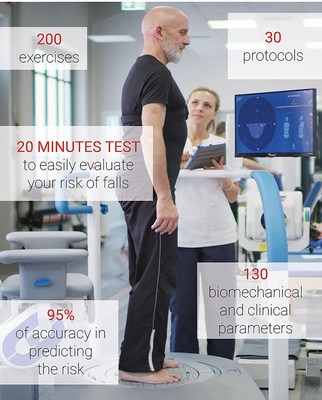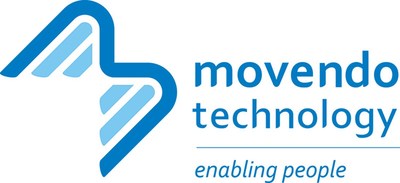Novel A.I.-based algorithm for falls prediction for adults over 65 years
Press Releases
Sep 08, 2020
GENOA, Italy, Sept. 8, 2020 /PRNewswire/ — 30% of people over 65 suffer from falls each year, which represent the second leading cause of accidental injury and death worldwide. In Europe, the European Public Health Association estimates that over 36,000 people die each year as a result of an accidental fall. Of these, 2.3 million go to the emergency room and 1.5 million are hospitalized, 650 thousand die. In the US, older adult falls cost about $50 billion a year.
Movendo Technology, in collaboration with Galliera Hospital in Genoa, Italy under the scientific supervision of Prof. Pilotto, concluded a 2-year clinical trial with 150 elderly patients published in the PLOS ONE magazine recently, leading to the Silver Index©.
The silver index is an objective measure predicting the risk of falls in elderly people and suggesting specific exercises and protocols aimed at minimizing the identified fall risk. Core of the 20-minute short evaluation is a proprietary A.I.-based algorithm combining the robotic measurements of hunova©, summarizing the existing clinical scales and providing an objective report with a personalized risk of falls map.
By objectively evaluating 130 parameters in a routine of 7 exercises and evaluations, the silver index is able to predict with the 95% accuracy the elderly’s risk of falls, a 15% improvement of traditional evaluation protocols.
The system is measuring a person’s biomechanical and neurological parameters in seated and standing position while simulating static and dynamic “perturbative” elements responsible for falls. This highlights the individual’s specific deficits and the resulting personalized rehabilitation intervention.
The evaluations are divided into a routine of 7 exercises including:
– Limits of stability and balance
assesses a person’s ability to move while maintaining balance without the need for support. Greater stability allows a person to carry out daily activities such as doing the stairs and leaving the house independently.
The balance exercises simulate the presence of an obstacle along the way that can throw off the balance a person.
– Sit-to-stand
used to measure the speed of repeating 5 times of sitting and standing up. This exercise allows to train a person to have greater stability and mobility in getting safely up from a chair or bed without help.
After the evaluation, the silver index indicates the best rehabilitation program for the person’s individual condition, suggesting the operator exercises and games the person can perform during the treatment and prevention.
The silver index is the first of a series of algorithms Movendo is developing, combining Artificial Intelligence and machine learning with clinical data. The goal is to develop a range of solutions based on an individual’s age and lifestyle in order to promote a prevention path based on an objective prediction.
The index success is confirmed also by the growing number of leading inpatients and outpatient clinical centers that are employing it in the daily practice and the fact that insurance companies are getting involved too, as its use can significantly support new business models based on prevention/prediction.
Other indexes, such as the “knee index”, allow to support the evaluation process of the knee evaluated for surgery helping the orthopedic surgeon making better clinical decisions and suggesting an ideal, personalized rehabilitation path – pre- and post-surgery.
hunova©
hunova is a programmable robotic medical device for both objective, functional evaluation and therapy that consists of two independent electromechanical movable platforms, one at foot level and one at seat level plus a wearable IMU sensor. The device can operate in active, passive, and assistive mode and includes over 200 exercises, macroareas and protocols. For neurological patients, hunova is used for post stroke functional re-education, for the treatment of degenerative diseases of the central nervous system and lesions of the peripheral nervous system, providing exercises of postural control, balance, core stability and proprioception. In orthopedics, hunova is used for trunk, hips, knee and ankle treatments, providing passive mobilization exercises, muscle strengthening, proprioceptive exercises and postural and balance control. In geriatrics, hunova enables the therapists to work on postural control, proprioception and balance, and it is used to prevent and evaluate the risk of falls in the elderly and the recovery of cognitive aspects.
About Movendo Technology
Founded in 2017, Movendo Technology, part of the biopharmaceutical group Dompé Holdings, develops and commercializes robotic and digital rehabilitation solutions for objective, functional assessments and effective treatments. hunova©, the company’s flagship product and one of the most versatile robotic assistive device available, improves orthopedic rehabilitation, the management or neurological and chronic conditions, active aging and athletic performance. Proprietary software algorithms and novel IT solutions provide for predictive and personalized therapy, telerehabilitation as well as for data-driven population health management tools
For additional information, please visit www.movendo.technology
![]() View original content to download multimedia:http://www.prnewswire.com/news-releases/novel-ai-based-algorithm-for-falls-prediction-for-adults-over-65-years-301125029.html
View original content to download multimedia:http://www.prnewswire.com/news-releases/novel-ai-based-algorithm-for-falls-prediction-for-adults-over-65-years-301125029.html
SOURCE Movendo Technology




